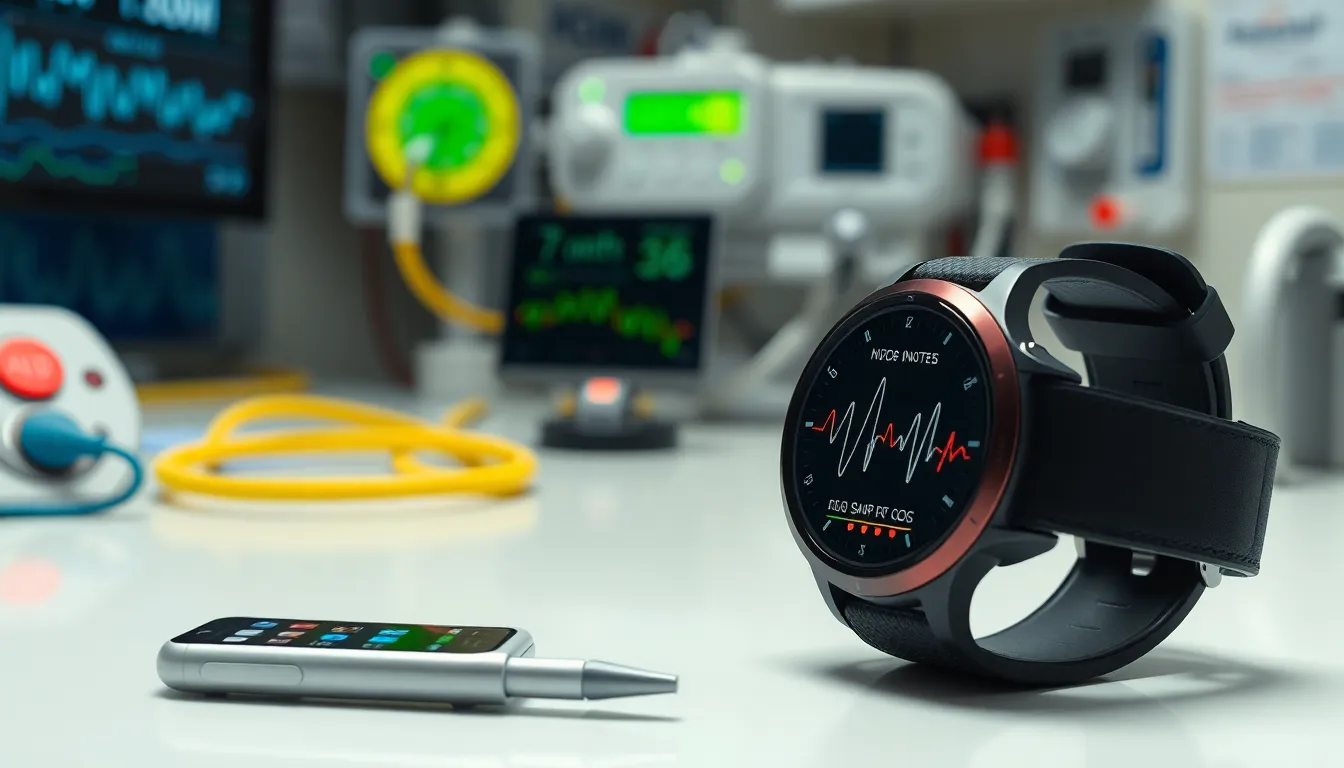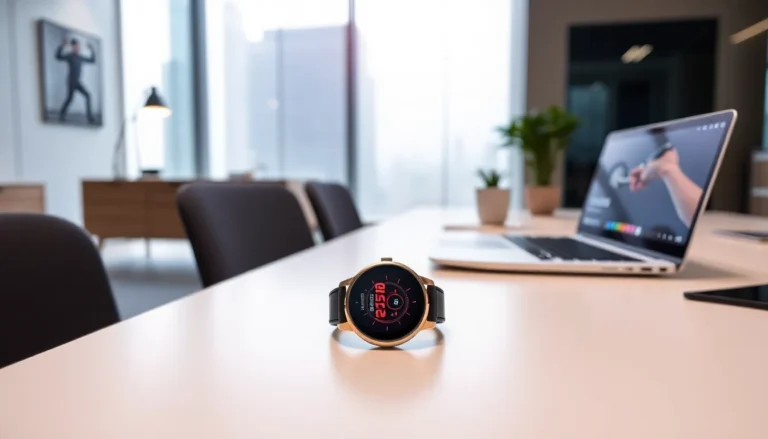In a world where fitness trackers are as common as coffee cups, medical-grade wearables are stepping up their game. These high-tech gadgets aren’t just for counting steps or monitoring heart rates; they’re revolutionizing healthcare by providing real-time data that can save lives. Imagine wearing a device that not only tracks your daily activity but also alerts your doctor if something’s amiss. Talk about a wearable that truly cares!
Gone are the days of guessing your health status. With medical-grade wearables, patients can take control of their well-being while doctors get a clearer picture of their health. It’s like having a mini doctor on your wrist, minus the awkward small talk. As technology continues to advance, these wearables are becoming essential tools in proactive healthcare, making it easier than ever to stay fit and fabulous.
Table of Contents
ToggleOverview of Medical-Grade Wearables
Medical-grade wearables represent a significant advancement in health technology. These devices offer precise health monitoring capabilities that enhance patient care and promote proactive health management.
Definition and Purpose
Medical-grade wearables refer to technologically advanced devices designed for clinical use. These gadgets track vital health metrics including heart rate, blood pressure, and glucose levels. Their primary purpose lies in facilitating real-time health monitoring, allowing patients to gain insights into their conditions. Clinicians benefit from accurate data, as these wearables can identify trends that support preventative care measures. Regulatory bodies ensure that these devices meet strict safety and efficacy standards, distinguishing them from standard consumer fitness trackers.
Key Differences from Consumer Devices
Consumer devices typically prioritize fitness and activity tracking. These wearables often lack regulatory oversight and clinical validation found in medical-grade options. Accuracy in measurement sets medical-grade devices apart, as they utilize advanced sensors and algorithms for reliable data collection. Medical wearables provide information necessary for diagnostic purposes, while consumer gadgets focus on general wellness. Furthermore, integration with healthcare systems enhances the utility of medical-grade wearables, allowing for seamless data sharing between patients and providers.
Types of Medical-Grade Wearables

Medical-grade wearables encompass a range of devices tailored for clinical applications, providing precise health monitoring and data collection.
Cardiac Monitoring Devices
Cardiac monitoring devices track heart rhythms and detect irregularities such as arrhythmias. These wearables typically utilize electrocardiogram (ECG) technology, allowing for continuous heart activity assessment. Clinicians access real-time data, enabling timely interventions when necessary. Patients benefit from peace of mind, knowing they can monitor their heart health conveniently. Some devices alert users to abnormal readings, prompting immediate consultation with healthcare professionals. Innovations in this space include smartwatches equipped with ECG capabilities that deliver clinically relevant metrics without the need for traditional monitoring.
Fitness and Activity Trackers
Fitness and activity trackers focus on capturing daily movement and health metrics like steps taken, calories burned, and sleep quality. While they share some features with consumer-grade fitness trackers, medical-grade versions offer enhanced accuracy and clinical insights. These devices often connect to healthcare systems to streamline data sharing with providers, ensuring comprehensive patient care. Specific models include those designed for rehabilitation, which can monitor progress in physical therapy. Accurate data collection fosters engagement in personal health management, empowering users to make informed lifestyle choices.
Benefits of Medical-Grade Wearables
Medical-grade wearables offer significant advantages in healthcare, transforming how patients and providers interact with health data.
Improved Patient Monitoring
Real-time health tracking enhances patient monitoring capabilities. Medical-grade wearables continuously collect vital signs, helping patients track conditions such as heart disease or diabetes. These devices alert patients and healthcare professionals to any abnormalities, promoting timely interventions. Regular data transmission keeps clinicians informed, allowing for proactive management of patient health. Patients gain reassurance by monitoring their conditions conveniently, ensuring better adherence to treatment plans. Overall, improved patient monitoring fosters collaboration between patients and providers.
Enhanced Data Accuracy
Data accuracy plays a crucial role in healthcare outcomes. Medical-grade wearables use advanced sensors and algorithms to ensure precise measurements of vital health metrics. These devices provide reliable data, allowing clinicians to identify trends and make informed decisions. Enhanced accuracy minimizes the risk of misdiagnosis and enables tailored treatment strategies for patients. Greater reliability leads to improved patient trust and engagement in their health management. With enhanced data accuracy, medical-grade wearables significantly improve the overall quality of patient care.
Challenges and Considerations
Medical-grade wearables face multiple challenges in their journey towards widespread adoption. Regulatory hurdles and data privacy concerns are among the primary considerations impacting their integration into healthcare systems.
Regulatory Approvals
Obtaining regulatory approval for medical-grade wearables proves challenging due to varying standards across regions. The FDA mandates rigorous testing to ensure safety and efficacy before market entry. Compliance with strict regulations can prolong the introduction of new devices, potentially delaying innovations. Manufacturers often invest significant resources into meeting these requirements. Successful navigation of the approval process leads to increased credibility and trust among healthcare providers and patients.
Data Privacy Concerns
Data privacy remains a crucial issue for medical-grade wearables, given the sensitive nature of health information. Users express concerns about how their data is collected, stored, and shared. Healthcare providers must adhere to regulations like HIPAA to safeguard patient information. Ensuring secure transmission and storage of data is essential to maintain patient trust. Manufacturers must prioritize robust encryption methods and transparent privacy policies to address these concerns effectively. Addressing these issues enhances user confidence and encourages broader adoption of medical-grade wearable technology.
Future Trends in Medical-Grade Wearables
Emerging trends in medical-grade wearables indicate significant growth in technology and integration within healthcare systems. These advancements reshape the landscape of patient monitoring and health management.
Advancements in Technology
Innovations in sensors and algorithms drive the accuracy and functionality of medical-grade wearables. Wearables now provide continuous monitoring for vital signs, offering enhanced insights into individual health conditions. More sophisticated features include AI capabilities that analyze data in real time, facilitating proactive health management. Companies are also focusing on miniaturization, making devices more comfortable without sacrificing performance. New materials and designs contribute to user-friendly experiences, encouraging broader adoption among patients.
Integration with Telehealth Solutions
The integration of medical-grade wearables with telehealth applications fortifies remote patient monitoring. This synergy enables healthcare providers to access real-time health data, fostering timely interventions. Patients benefit from virtual consultations that incorporate insights from wearables, enhancing the overall care experience. Moreover, streamlined data sharing capabilities between wearables and telehealth platforms ensure seamless communication. This integration supports a holistic approach to patient care by bridging the gap between technology and healthcare services.
Medical-grade wearables are revolutionizing healthcare by providing real-time health data that empowers both patients and providers. These devices enhance patient monitoring and promote proactive health management, ensuring timely interventions and tailored treatment strategies. As technology continues to evolve, the integration of advanced sensors and AI capabilities will further improve the accuracy and functionality of these wearables.
Despite challenges like regulatory hurdles and data privacy concerns, the future of medical-grade wearables looks promising. Their ability to seamlessly connect with healthcare systems supports a holistic approach to patient care. As they gain traction, these wearables are set to play a crucial role in transforming health management and elevating the quality of care patients receive.









